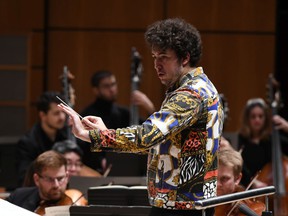
Reviews and recommendations are unbiased and products are independently selected. Postmedia may earn an affiliate commission from purchases made through links on this page.
Article content
“Our living composers are the torchbearers for the future,” said conductor Alexander Prior at a scintillating concert at the Winspear Friday night.
advertisement 2
Article content
There was scarcely a cough or a rustle all evening—instead, rapt attention and considerable enthusiasm, showing there really is a demand for this kind of new and recent music.
Some had come because they were curious. Some had come because they knew it was probably their only chance of hearing a symphony live by the Soviet composer Galina Ustvolskaya. Some had come to hear new music by four really talented Canadian women composers.
It was a cornucopia of a concert, running the gamut of extreme emotions, and including some fine solo playing. Timpanist Barry Nemish filled the hall with a virtuoso solo performance of Peter Eötvös’ Thunder for bass pedal timpani. Megan Evans showed what a fine horn player she is—what a lovely lyrical tone—in Nielsen’s Canto serioso for French horn and piano, here orchestrated very sympathetically by Prior himself, with some luminous Nielsen touches.
advertisement 3
Article content
Violin soloists Ewald Cheung and Yue Deng floated over the orchestra in Reich’s poetic Duet for two solo violins and string orchestra, as if the minimalist composer was inspired by Vivaldi’s mixture of soloists and orchestra.
Only Philip Glass’s Prelude and Dance from his opera Akhnaten, which opened the concert, was curiously muted, apart from DT Baker’s effective narration. Surprisingly, it was the first time the ESO had ever played Glass; it may be notoriously difficult music to play, but it did need more dynamic range.
Nicole Lizée’s three-minute Zeiss After Dark, the only work in the concert the ESO had played before, dazzled, though I’m not as convinced as Prior that it is more than just an occasional piece.
advertisement 4
Article content
The concert, though, was dominated by three works by three female composers, music of such power and effect that they seemed to cover the entire zeitgeist of our troubled age.
The first was A Child’s Dream of Toys by Edmonton-born Vivian Fung. Her music by Ella has really matured into a powerful and individual idiom in the last few years, and this 11-minute work is an intense virtuoso masterpiece for orchestra. As its title might suggest, there is the helter-skelter frenetic energy of a small child, dazzling in its sharp colors and busy orchestral textures.
In the middle that energy seems almost to completely drain, as if the child has gone to sleep, complete with snore-like sounds from double-basses and brass. A couple of blasts from a whistle wake everyone up, but things remain magical, until the mood of the opening returns.
advertisement 5
Article content
The music really does get inside the crowded world of dreams and toys. I was reminded of Where the Wild Things Are, but there is nothing sentimental or pseudo-romantic about this work. It delights in colors that are stark and blunt and joyful and honest. It is indeed music for our time.
In contrast, but complementing it so well, was the premiere of a new work by another Edmonton-born composer, Alissa Cheung. Impressions is a haunting, magical, mesmerizing and slow-moving combination of quiet orchestral textures that almost imperceptibly build up to a conclusion of considerable emotional power.
It is built on the simplest of materials, notably a three-note chorale-like figure in the brass. It could be a seascape — certainly, it feels very Nordic with its hints of whale cries and seabird calls deep in the orchestral textures at the opening. Finally, at the end, the brass three-note figure is heard again, and, with all instruments silent, the entire orchestra hums the three notes. It is an extraordinarily moving moment.
advertisement 6
Article content
Everything that happens in the piece, even if not expected, seems to effortlessly take place just when it should — the hallmark of the best composers. Astonishingly, given its orchestral mastery, this is Cheung’s first orchestral piece.
Finally came Ustvolskaya’s 13-minute Symphony No.5 for five players and a reciter, here Prior dramatically declaiming the Lord’s Prayer in Old Church Slavonic. This is one of the most terrifying pieces of music ever written, relentlessly in its musical dissection of the horrors of the world. It’s as if Stravinsky’s The Soldier’s Tale had evolved into a post-holocaust inevitability of death knocking on the door. Indeed, death seems to do just that in the constant horrific striking of hard mallets on a specially constructed wooden box. A marvelous, harrowing performance by all concerned.
advertisement 7
Article content
These three pieces seemed to encompass our times: sparkling but hard and complex joy in the Fung, mediation and peace and perhaps a sense of possible despair in the Cheung, the horror that seems to reflect the terrible Ukrainian events in the Ustvolskaya. Together, they seemed to echo that classic Greek idea of the wisdom of the ages of women: the young woman in Cheung, the mother in Fung, the old grandmother in Ustvolskaya.
Fortunately, the ESO are recording the Cheung in May. But this is a concert that should have been broadcast by a national broadcaster, to show what torches our extraordinary new generation of Canadian composers are carrying, and the orchestral forces who are lighting them up.
REVIEW
Edmonton Symphony Orchestra concert ‘Glass’
Driver: Alexander Prior
Soloists: Ewald Cheung, Yue Deng, Megan Evans and Barry Nemish
Where: Winspear Center
When: April 29